Virtual assessment of e-powertrains using the Hybrid Optimization Tool

Diversity of vehicle architectures
After decades of focusing on the optimization of internal combustion engines and ensuring their exhaust after-treatment systems pass regular updates of the emissions regulations, the transport industry is going through dramatic changes. Challenged by the implementation of new standards presenting a major turning point on CO2 and GHG emissions targets, all transportation sectors have to rework their powertrains and adopt new technologies.
The automotive industry is fully engaged in the implementation of electrified or full electric powertrains and the trends is followed by most of on-road and off-road segments. Indeed, this offers a concrete way – at least – to drastically reduce the emissions during vehicle operation. The challenge is then to adopt the right architectures and embed the right technologies with an optimized sizing… according to the regulations, the costs and product requirements.
In parallel, more conventional approaches are also developed or foreseen, focusing on adaptations of a well-know system: the ICE which can be fed with alternative fuels like natural gas in ships, or even hydrogen in trucks…
Finally, the automotive, truck and off-highway manufacturers are offered a large variety of options to reduce the C02 footprint of their fleets however, they are in need of support to make the right decisions.
Simcenter Amesim for architecture evaluations
Simcenter Amesim is used for the virtual assessment of e-powertrains using the Hybrid Optimization Tool. It is well-equipped to support quick evaluation and benchmarking of vehicle architectures including conventional, hybrid and electric powertrains. This relies on a workflow built around the Hybrid Optimization Tool [1] which supports the preliminary assessment of fuel economy, range and performance of vehicles. Once this first step completed, HOT can automatically create a fully parameterized sketch for the studied vehicle models, including an ECMS supervisor and a driver model, opening the door to further multi-attributes analysis using the power of multi-physics modeling capabilities.
Simcenter Amesim Hybrid Optimization Tool
The Hybrid Optimization tool is dedicated to the evaluation of… hybrid architectures but the concept has been extended in order to offer the capacity to evaluate a broad range of vehicle architectures from conventional to pure electric in the same environment.
On the hybrid side, the tool does cover a large variety of configurations, including P0/P1/P2/P3/P4 but more exotic combinations of the thermal engine, electric motors and fuel cell are also possible, possibly completed with plug-in capabilities.
For instance, this opens the door to a direct comparison of two hydrogen-powered vehicles with fuel-cell on one hand and H2-ICE on the other hand!
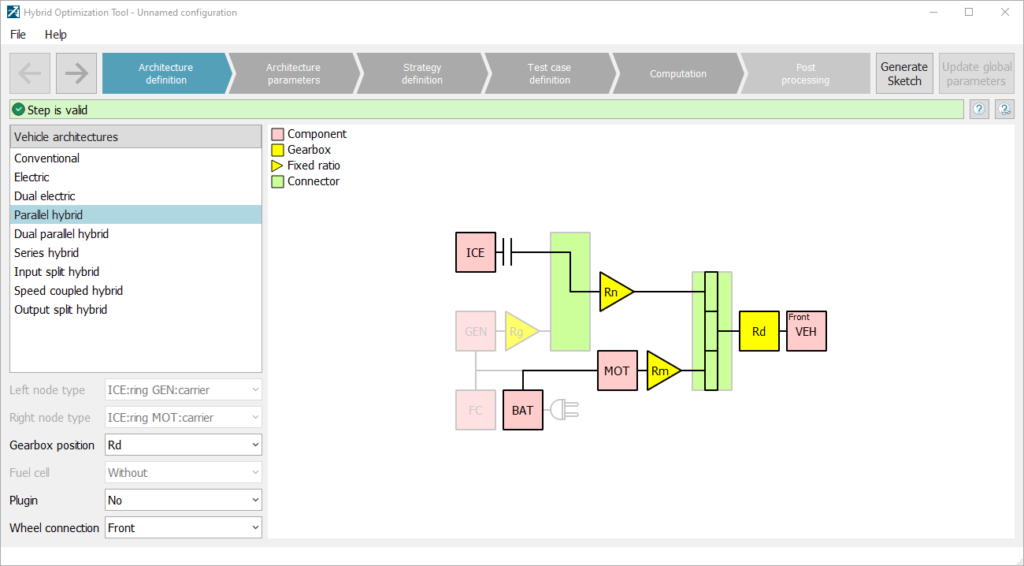
HOT is an off-line optimization tool. It computes the optimum energy management of a given configuration on a given scenario using an indirect optimal control method. Hence, the main outputs of the tool are the split of power between the thermal engine and electric motors and the resulting optimized fuel consumption. For a conventional vehicle, only the gear shifting strategy can be optimized and for an electric vehicle (with no gearbox)…a simple electric consumption is evaluated.
On top of these prediction of the vehicle energy management and optimal fuel consumption, HOT has been completed with capacity to compute vehicle performance (0-100kph, max speed, 80-120kph etc…) in order to ease the evaluation and benchmarking of configurations.
HOT must be fed with characteristic data for every single component in the assembly.
Since it is based on a quasi-static modeling approach, simple performance maps are required (fuel consumption map for the ICE, e-motor efficiency map, …). They can be provided by the user directly in the GUI, when they are available. Otherwise, users can also take advantage of the three companion tools to generate consistent data from basic product information sheet.
The companion tools
The three main tools highlighted below, aim to deliver consistent component characteristic maps from basic performance data, for the three key components of the powertrain: the thermal engine, electric motors and battery. These are based on scaling factors, application-oriented correlations, knowledge-based algorithms.
The ICE Tables creator, computes the engine torque and power curves as well as friction and fuel consumption maps from simple engine parameters like: number of cylinders, displacement, max performance figures and basics of the controls.
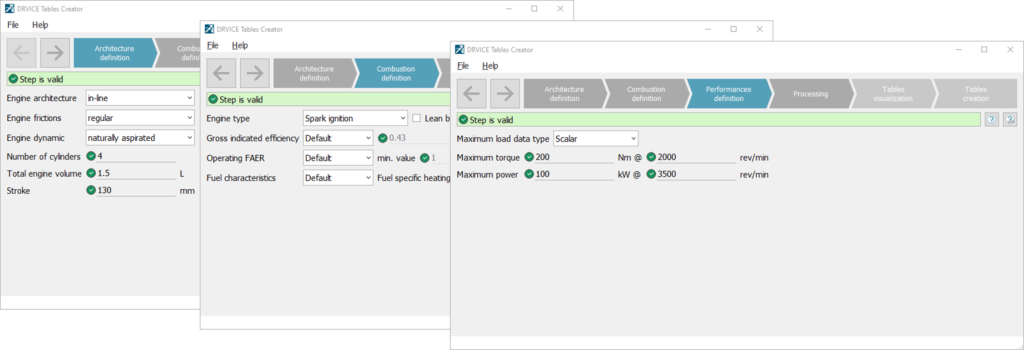
The tool provides consistent data set whatever the use case and can be applied successfully for a large range of applications from automotive, truck and even large-displacement engines.
The main objective of the Electric Motor Tables creator is to provide the electric losses map for the electric motor(s). Several motor technologies have been implemented, which are the most widespread into HEV.
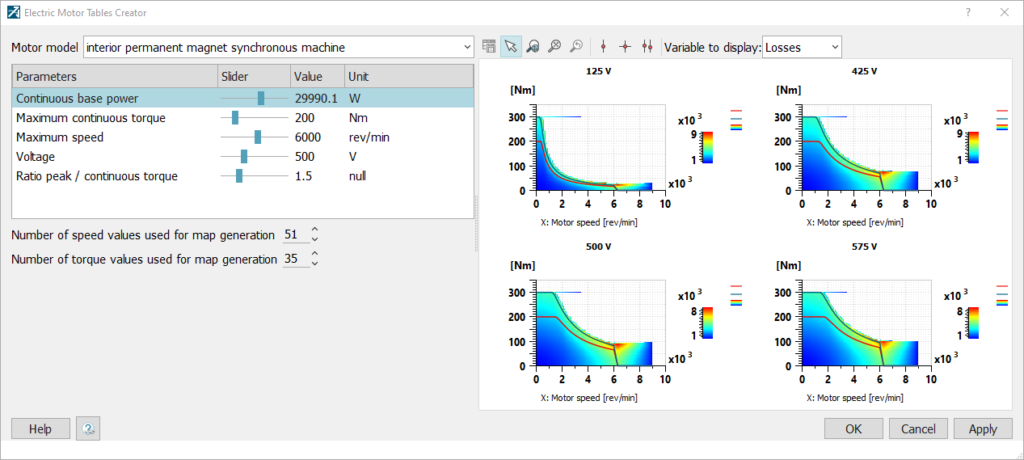
Following the same philosophy as the ICE tool, the e-motor tool generates a set of consistent data and maps directly read by HOT.
The third tool is the Battery Pre-Sizing Tool. The basis of the methodology is to find dimensionless scaling laws for battery characteristics (internal resistance, open circuit voltage, entropy, weight) related to cell nominal capacity. Those dimensionless characteristics depend on the cell State of Charge (SoC), its power/energy ratio and the temperature.
The tool requires data from the user, for example; the battery power, enegy, nominal voltage, number of branches and reference SOC and temperature. The cell chemistry is selected in a list of four Li/ion technologies.
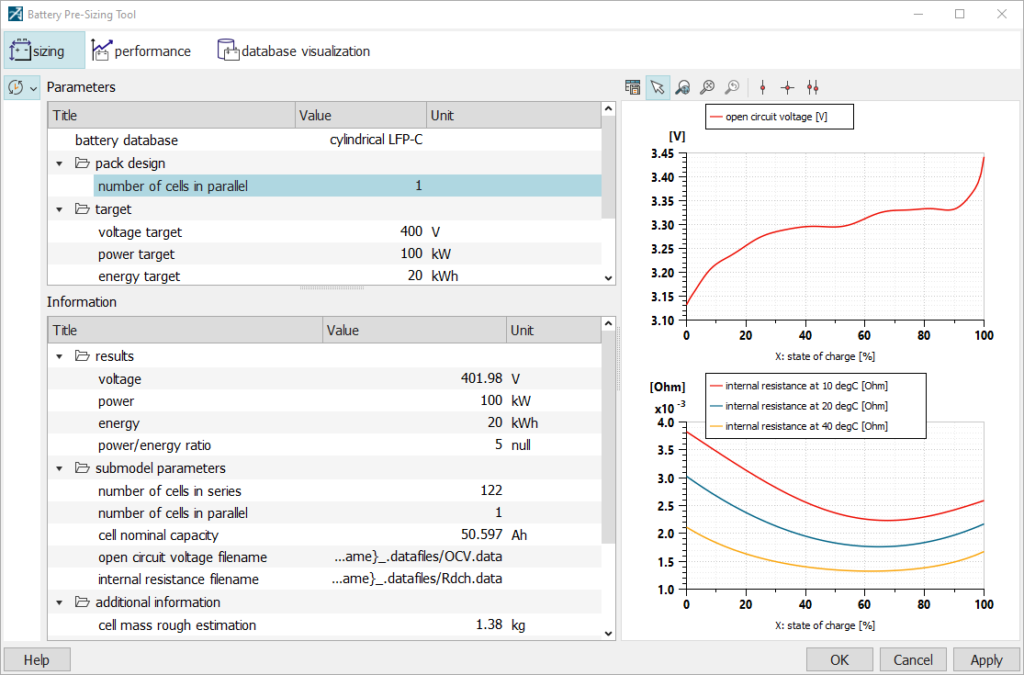
Last but not least, a simple GUI supports the definition of the vehicle parameters and tyre frictions in particular.
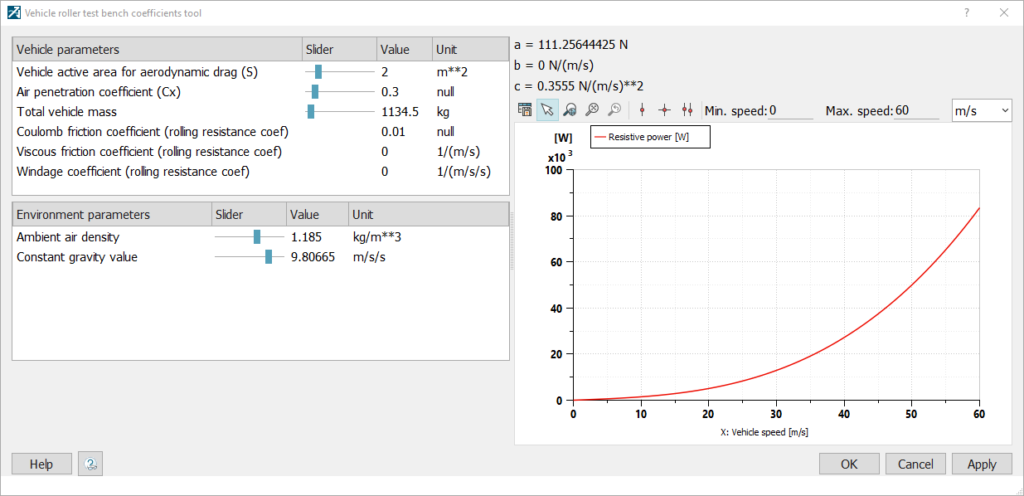
The ECMS
The only dynamics considered in HOT is the battery state of charge. For these reasons, HOT results should be regarded as ideal ones, to be used as a basis of comparison in the very early stages of a design process.
In the next design or assessment steps, HEV simulation should take into account the dynamics of all the main components, as well as use an ‘online’, causal EMS that does not have any prior knowledge of
the future driving situations. Such a strategy should be as close as possible to the ideal strategy in order to achieve quasi-optimal results.
Up to now, commercial software has left the task of designing EMS to the user. Typically, either empty control blocks are to be filled ‘at hand’ for each configuration simulated… or general-purpose controllers based on heuristic rules are available in the software libraries. In the latter case, however, rule-based EMS do not generally achieve optimal energy management.
The Hybrid Optimization Tool integrates the capability to fill this gap and automatically generate a causal and quasi-optimal EMS to be used in dynamic HEV simulation. The strategy generated is the ‘equivalent consumption minimization strategy’ (ECMS) that, similarly to HOT, is based on optimal control theory.
In practice, once set in the HOT tool, a sketch can be generated within Simcenter Amesim using components from the IFP-Drive library, including a driver model and the ECMS. All the data and parameters are transferred in the process in no time. Then, the user can complete their analysis in a dynamic context and apply batch run capabilities or optimization to further development his powertrain concept.
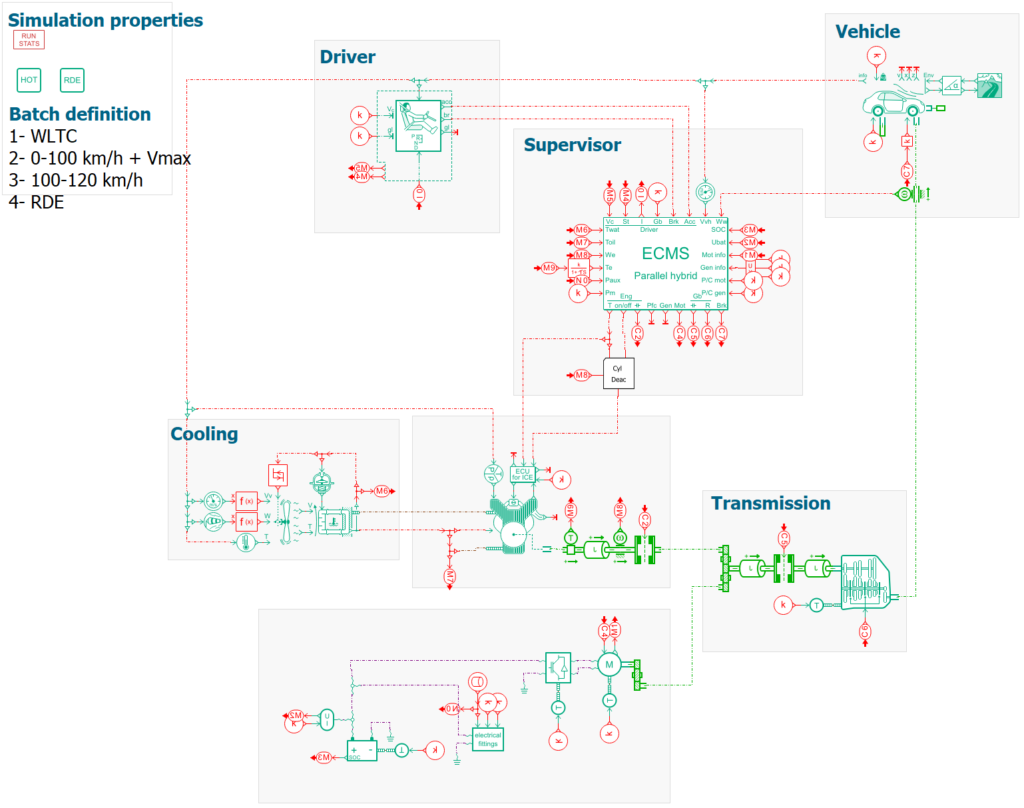
The aim of HOT and the ECMS is to support the very first steps of vehicle engineering but they open the door to further analysis and developments. Indeed, the sketch created can be completed and complexified according to the user need and take advantage of the physical modeling approaches applied to any sub-system. Hence, multi-attributes balancing is made possible.
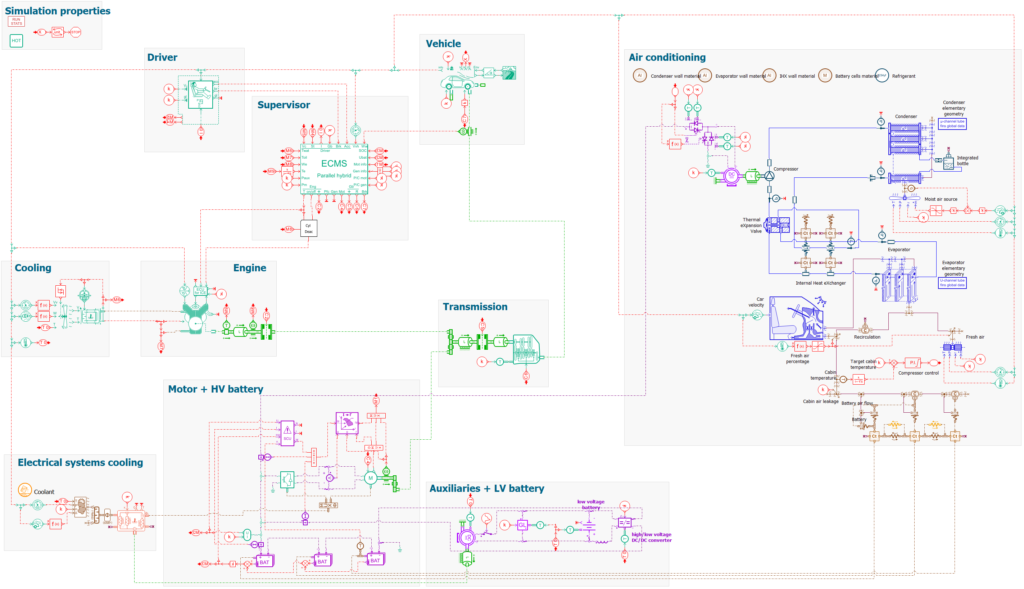
In this article we have shown how to use Simcenter Amesim for the virtual assessment of e-powertrains using the Hybrid Optimization Tool.
As a conclusion, the combination of HOT with its companion tools, the ECMS in an industrial workflow offers Simcenter Amesim users, a solution to quickly benchmark vehicle architectures and variants. The automatic set-up of fully parametrized vehicle models in no time, can boost your vehicle engineering activities.
[1] SAE paper 2017-24-0173, “Automatic Generation of Online Optimal Energy
Management Strategies for Hybrid Powertrain Simulation”, Jean-Charles Dabadie, Antonio Sciarretta, Gregory Font, and Fabrice Le Berr.
Some of the latest developments on the HOT and ECMS workflow have been conducted in the framework of the LONGRUN project.

This project LONGRUN has received funding from the European Union’s Horizon 2020 research and innovation program under grant agreement no 874972.
https://h2020-longrun.eu/
Learn more
- Watch our Tech Tip video below to learn how to quickly assess the potential of vehicle architectures using Simcenter Amesim.
- Read this blog article on Hydrogen-fueled internal combustion engine
About the author:
Vincent THOMAS is Senior Product Line Manager for Simcenter Amesim. He has been supporting the internal combustion engine business for more than 20 years, leveraging a long-lasting collaboration with IFP Energies nouvelles to deliver to the market best-in-class system modeling and simulation capabilities to serve industry challenges.


